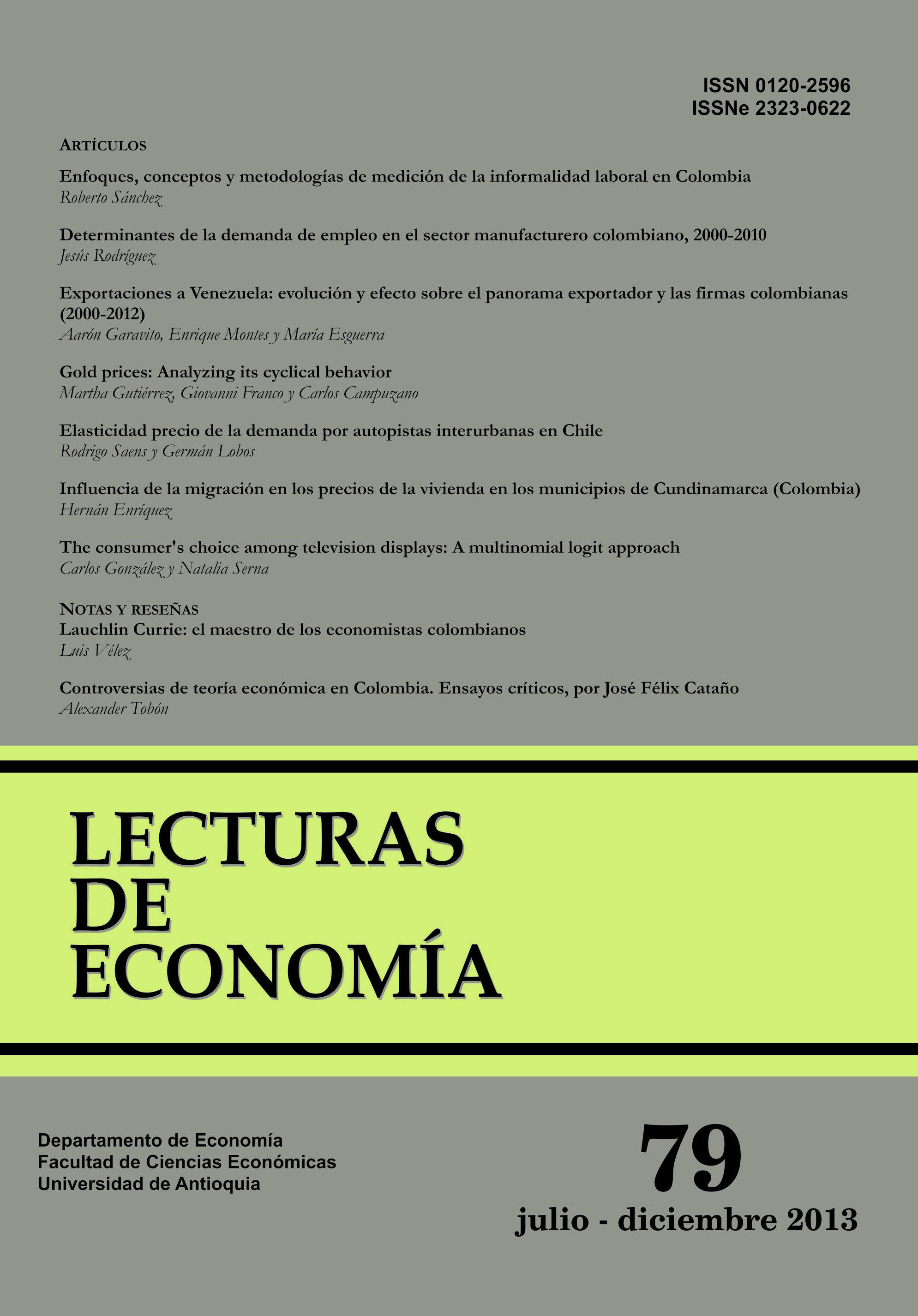Gold prices: Analyzing its cyclical behavior
DOI:
https://doi.org/10.17533/udea.le.n79a4Keywords:
Gold cycle, DJIA/GF ratio, Fourier analysis, neural network forecastAbstract
Gold is a commodity that is seen as a safe haven when a financial crisis strikes, but when stock markets are prosperous, these are more attractive investment alternatives, and so the gold cycle goes on and on. The DJIA/GF (Dow Jones Industrial Average and Gold Fix ratio) is chosen to establish the evolution of gold prices in relation to the NYSE. This paper has two goals: to prove that the DJIA/GF ratio is strongly cyclical by using Fourier analysis and to set a predictive neural networks model to forecast the behavior of this ratio during 2011-2020. To this end, business cycle events like the Great Depression along with the 1970s crisis, and the 1950s boom along with the world economic recovery of the 1990s are contrasted in light of the mentioned ratio. Gold prices are found to evolve cyclically with a dominant period of 37 years and are mainly affected by energy prices, financial markets and macroeconomic indicators.
Downloads
References
Aizenman, Joshua & Inoue, Kenta (2013). “Central banks and gold puzzles”, Journal of the Japanese and International Economies, Vol. 28, pp. 69–90.
Álvarez, Jose & Rodríguez, Eduardo (2011). “Long-term Recurrence Patterns in Late 2000 Economic Crisis: Evidences from Entropy Analysis of the Dow Jones Index”, Technological Forecasting and Social Change, Vol. 78, Issue 8, pp. 1332–1344.
Batten, Jonathan; Ciner, Cetin & Lucey, Brian M. (2010). “The macroeconomic determinants of volatility in precious metals markets”, Resources Policy, Vol 35, Issue 2, pp. 65–71.
Baur, Dirk G. & Mcdermott, Thomas K. (2010). “Is gold a safe haven? International evidence”, Journal of Banking and Finance, Vol. 34, Issue 8, pp. 1886–1898.
Cashin, Paul; McDermott, John C. & Scott, Alasdair. (2002). “Booms and Slumps in World Commodity Prices”, Journal of Development Economics, Vol. 69, Issue 1, pp. 277–296. Retrieved from http://www.sciencedirect.com/science/article/pii/S0304387802000627 (April 27,2013 ).
Christie–David, Rohan; Chaudhry, Mukesh & Koch, Timothy W. (2000). “Do macroeconomics news releases affect gold and silver prices?”, Journal of Economics and Business, Vol. 52, Issue 5, pp. 405–421.
Craig, Lee A.; Fisher, Douglas & Spencer, Theresa A. (1995). “Inflation and money growth under the international gold standard, 1850–1913”, Journal of Macroeconomics, Vol 17, Issue 2, pp. 207–226.
Devore, Jay L. (2006). Probabilidad y Estadística para Ingeniería y Ciencias. California, San Luis Obispo: International Thomson editores.
Kearney, Adrienne A. & Lombra, Raymont E. (2009). “Gold and platinum: Toward solving the price puzzle”, The Quarterly Review of Economics and Finance, Vol. 49, Issue 3, pp. 884–892.
Kitco (2013). 10 Year Gold. Retrieved from: http://www.kitco.com/charts/popup/au3650nyb.html (March 03, 2013).
Kreizig, Erwin (2006). Advanced Engineering Mathematics (9th ed). Hoboken, NJ: Wiley Eastern.John Wiley & Sons, Inc.
LBMA (2012). London Bullion Market Association. Retrieved from http:// www.lbma.org.uk/pages/index.cfm (March 15, 2013).
Lili, Li & Chengmei, Diao (2013). “Research of the Influence of Macro-Economic Factors on the Price of Gold”, Procedia Computer Science, Vol. 17, pp. 737–743.
Lothian, James R. (2002). “The internationalization of money and finance and the globalization of financial markets”, Journal of International Money and Finance, Vol. 21, Issue 6, pp. 699–724.
Marketwatch.com (2011). Dow Jones Industrial Average. Retrieved from http://www.marketwatch.com/investing/index/djia (December 21, 2011).
Mollick, Aandrè Varella & Assefa, Tibebe Assefa (2013). “U.S. stock returns and oil prices: The tale from daily data and the 2008–2009 financial crisis”, Energy Economics, Vol. 36, pp. 1–18.
Neuro Dimension Inc. (2012). Neuro Dimension. Retrieved from: http:// www.nd.com/neurosolutions/products/ns/whatisNN.html (September 21, 2012).
Parisi, Antonino; Parisi, Franco & Díaz, David (2008). “Forecasting gold price changes: Rolling and recursive neural network models”, Journal of Multinational Financial Management, Vol. 18, Issue 5, pp. 477–487.
Prechter, Robert (2009). Gold & Silver. Retrived from: http://www.bullionworks.com/images/Gold_Silver_Ebook.pdf (March 03, 2013).
Shachmurove, Yochanan (2011). “A historical overview of financial crises in the United States”, Global Finance Journal, Vol. 22, Issue 3, pp. 217–231.
Shafiee, Shahriar & Topal, Erkan (2010). “An overview of global gold market and gold price forecasting”, Resources Policy, Vol. 35, Issue 3, pp. 178–189.
Smith, Eric & Shubik, Martin (2011). “Endogenizing the provision of money: Costs of commodity and fiat monies in relation to the value of trade”, Journal of Mathematical Economics, Vol. 47, Issue 4-5, pp. 508–530.
Straßburg, Janko; Gonzàlez-Martel, Christian & Alexandrov, Vassil (2012). “Parallel genetic algorithms for stock market trading rules”, Procedia Computer Science, Vol. 9, pp. 1306–1313.
Timo, Hämäläinen; Klapuri, Harri; Saarinen, Jukka; Ojala, Pekka & kaski, Kimmo (1996). “Accelerating genetic algorithm computation in tree shaped parallel computer”, Journal of Systems Architecture, Vol. 42, Issue 1, pp. 19–36.
Williams, James L. (2012). Oil Prices History and Analysis. Retrieved from: http://www.wtrg.com/prices.htm (September 21, 2012).
Wolfram Mathematica (2013). Fourier Series. Retrieved from: http:// reference.wolfram.com/legacy/v8/ref/Files/FourierSeries.en/O_2.gif (July 17, 2013).
Yonaba, H.; Anctil, F. & Fortin, V. (2010). “Comparing Sigmoid Transfer Functions for Neural Network”, Journal of Hydrologic Engineering, Vol. 15, Issue 4, pp. 275–283.
Downloads
Published
How to Cite
Issue
Section
License
This page, by Universidad de Antioquia, is licensed under a Creative Commons Attribution License.
Authors who publish with this journal agree to retain copyright and grant the journal right of first publication, with the article licensed under a Creative Commons Attribution-NonCommercial-ShareAlike License allowing others to share it as long as they acknowledge its authorship and original publication in this journal.
Authors can enter into separate, additional contractual arrangements for the non-exclusive distribution of the journal's published version of the work (e.g., post it to an institutional repository or publish it in a book), provided that these arrangements be not for profit and the journal be acknowledged as the original source of publication.
Authors are permitted and encouraged to post their papers online (e.g., in institutional repositories or on their websites), as it can lead to valuable exchanges as well as greater citation of the published work.















